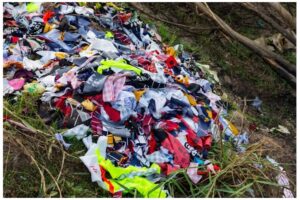A recent report from the European Environment Agency (EEA) has exposed a troubling practice: 90% of used clothes and textile waste from European countries are being exported to Africa and Asia. This revelation underscores the urgent need for Europe to address its irresponsible waste management practices and take greater responsibility for its textile trade.
Europe’s heavy reliance on Asia and Africa for low-cost manufacturing has led to an overwhelming surplus of used clothes and textile waste. While this may have been profitable for businesses, the environmental consequences are alarming.
The EEA report reveals that textile consumption in the European Union ranks high in land use, water consumption, material resource utilization, and greenhouse gas emissions. The production of textiles also introduces harmful chemicals that contribute to climate change.
Synthetic textiles, derived from fossil fuel resources, are a particular concern. They are prevalent in everyday items such as clothing, household textiles, and automotive components.

Also, read; Gap Files $2 Million Lawsuit Against Kanye West Following Failed Collaboration
The production, consumption, and improper disposal of synthetic textiles not only contribute to greenhouse gas emissions but also deplete non-renewable resources and release harmful microplastics into the environment.
Annually, Europe generates around 5.8 million tonnes of textile waste, with synthetic fibers accounting for two-thirds of this waste. While some waste is recycled within Europe, the majority is exported to Africa and Asia due to limited local recycling capabilities. In 2019, Africa received over 60% of EU textile exports, with Asia’s share increasing significantly to 41% of EU imports.
The fate of these exported textiles is uncertain, as there is a lack of documented information regarding their reuse, recycling, or disposal in recipient countries. African nations primarily utilize imported textiles for local reuse, but unsuitable items often end up in landfills.
Asian countries process used textiles in economic zones, downcycling them into industrial rags or filling materials. Textiles that cannot be recycled or re-exported may ultimately end up in general waste management systems, including landfills.

To protect the environment and combat climate change, Europe must address this harmful practice. It needs to prioritize sustainable waste management practices, invest in local recycling capabilities, and reduce its reliance on exporting textile waste.
Collaboration between European countries and African and Asian nations is essential to find effective solutions and establish responsible trade practices that protect the environment and promote a circular economy.
By ending the dumping of used clothes on Africa and Asia, Europe can demonstrate its commitment to environmental sustainability and set an example for responsible consumption and waste management worldwide.

